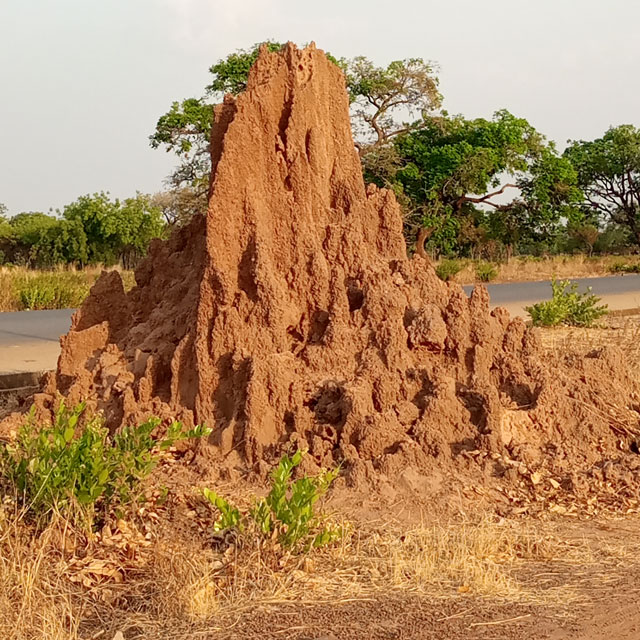
Kitgum, Uganda | THE INDEPENDENT | Whenever an anthill starts thriving in Patrick Ojok’s farmland, he climbs his bicycle and rides over 30 kilometers to an agro-input dealers’ shop, to buy a termiticide to kill it. Anthills, soil mounds that stand in the midst of farmlands or backyard gardens, are formed by termites and other animal species in the soil.
They also provide shelter for white ants and termites. However, most farmers consider termites as pests to both cash and food crops. With instructions from the Agro-input dealer, Ojok mixes the lethal chemical with water, pours it into the anthill through its ventilator and it dies. His reason for killing anthills is only one; they destroy his crops.
“People kill anthills for only two or even one reason: because termites destroy their crops. After planting and the crops are doing well, the termites attack the crops from the roots.”
Ojok, a resident of Onya Central Village in Ibakara Parish, Kitgum Matidi Sub-county in Kitgum district, has been killing the anthills since 1999 when he was only 17 years old. Now 41 years old, he recounts that he has chemically terminated more than ten (10) anthills.
But that number could double because he has another means of killing the anthills. Getting a tin of termiticide costs him between UGX 15,000 to UGX 80,000, depending on the result he desires or how big the mound is. However, since Ojok, just like any other farmer incurs several other pre-and post-harvest costs, he sometimes uses water to get rid of the anthills, to cut costs.
Just like the rooms in a big house, an anthill has interconnected chambers that are purposed for storing food and trash. Others act as a nursery or queen’s compartment. If the anthill is near a waterway, Ojok creates a diversion so that the water flows into the sections through the ventilation holes. He knows that when water enters the different compartments, it weakens the termitarium, hence, putting an end to the entire termite colony, rendering the anthill barren.
“If you can’t afford a termiticide, and the anthill is near flowing water, then you can create a diversion to direct the water inside the anthill through its ventilators into the “a big pot” which is inside an anthill. This is where the termites keep their arms, termite kings and queens, and the rest. When the water reaches the “pot”, it dissolves it. The dissolution of the “pot” means all termites will die. And the death of the termite queens signifies the death of the anthill.”
About fifty-four kilometers outside Kitgum Municipality, Chris Nyeko narrates that farmers use ash liquids to kill “stubborn” anthills. The method involves mixing ash with water with a porridge-like density in a big container of about 10-15 liters. The farmer then digs a hole at the peak of the anthill, pours the ash mixture into the anthill, and tightly covers the hole with leaves. Between 6-8 days, the anthill will start emitting a pungent smell that engulfs the surroundings.
“Our assumption is that the smell signifies the death of the termite colony. Some anthills sink in after that time,” Nyeko explains. Nyeko, a 26-year-old resident of Pugoda West Village in Namokora Sub-County, first saw his father use ash mixtures to kill anthills in 2004 when he was only about six or seven years old.
Barnabas Opiyo, the senior entomologist at Kitgum District Local Government acknowledges that farmers destroy anthills solely because the termites that inhabit them destroy crops. However, this seemingly destructive activity is beneficial to the soil and farmers.
Termites, also referred to as “ecosystem engineers”, augment soil changes, as they collect organic matter and mineral particles from different depths and deposit them in anthills, thereby increasing the content of organic compounds, clay, and nutrients.
Besides breaking down organic matter, Opiyo explains that termites eat up the fraction of soil that consists of plant and animal tissues in various stages of decomposition, and pass it out through their excrement. These excreta also help in recycling soil nutrients.
Opiyo also agrees that termites are more predominant now, because of the effects of climate change. According to Opiyo, litter decomposition is mainly performed by soil microorganisms in situations of adequate rainfall. However, because of the erratic rain, the termites, which are housed by the anthills are actively taking up the role of the other micro-organisms to decompose plants and plant wastes to form soil.
He says although considered destructive to crops, anthills are indispensable. The potential of hydrogen (pH) and the population of microbes are reported higher in anthills than in the soils surrounding it, implying that the anthill soils are similar to organic fertilizer.
Opiyo explains that the anthill soils can be naturally distributed in the gardens, especially around the fringes of the anthills. Their high fertilizer-like abilities are noticed by the health of plants that grow nearby, compared to plants in other parts of the same garden.
According to Opiyo, only 1% of farmers in Kitgum use chemical fertilizers, a factor he attributes to their high costs, and advises that anthill soils could be the best and cheapest alternative. Although the anthill soils are naturally redistributed through soil erosion when it rains, Opiyo suggests that farmers can collect the anthill soils and sprinkle them in their gardens as organic fertilizer, because they improve soil texture and clay content.
Depending on a farmer’s need, or fertilizer placement, they can determine which anthill soil to use by the size of the anthill.
A 2017 study on; “The potential of anthill soils in agriculture production in Africa, published in the International Journal of Biosciences, notes that ants’ and termites’ activities effectively contribute to shifting physical soil properties such as permeation and absorbency, soil microbial community, animal population in a given area and rates of decay of organic matter. They also modify soil that is deep under into nutrient-rich pouches conducive for seed growth.
Ojok understands the magic in anthill soils and explains almost expertly, why it facilitates plant health.
“The anthill soils in indeed like a fertilizer because the soil that forms the mounds is brought by termites from underneath the ground. After getting the soil from down under, in addition to whatever they do to the soil, which I can’t tell because I didn’t research it, is the reason plants are always healthier where anthills are.”
Sometimes, Ojok tries to ignore the anthill and manage by opening up virgin land for cultivation but says for the last five years, he has noticed more termite activity in his crop gardens, and it feels like the termites have multiplied ten-fold. The only alternative, he says, is now to “kill them all.”
“Some gardens have like 40 anthills. Imagine the level of destruction they will do to the crops. If I leave them untouched, it would seem like I’m promoting a project for anthills,” he said. However, Opiyo notes that given the ever-changing climate and unreliable rain, farmers should leave anthills alone.
Dr. Alfred Obia, a soil scientist and plant nutritionist at Gulu University says several benefits may arise when anthill soil is used, because of its associated higher clay and organic carbon contents, hence acts as a soil amendment. “Higher clay and organic carbon contents tend to improve soil physical properties including increased soil water retention, which is advantageous in dry spells,” Obia noted in an email interview.
Researchers have found documented evidence of smallholder farmers in African countries such as Niger, Malawi, Sierra Leone, Tanzania, Uganda, Zimbabwe, and Zambia digging up and moving anthill soils to spread in their fields to improve soil fertility. However, some advice is that farmers should first get the anthill soil diggings tested to get a proper balance of nutrients in the fields, as some anthill soils are alkaline.
Alkaline soils are known to prevent plants from absorbing several essential nutrients because they contain high levels of calcium carbonate. Dr. Obia notes that although research in some countries shows that anthill soil has been used to amend soil fertility, farmers in northern Uganda have yet to practically do it. “In northern Uganda, I have not yet come across farmers moving ant hill soil from one point to another but spreading the soil where the ant hill is, has been happening.”
******
URN | This story was produced with support from the Agroecology School for Journalists and Communicators and the Eastern and Southern Africa Small Scale Farmers’ Forum (ESSAF) Uganda.
 The Independent Uganda: You get the Truth we Pay the Price
The Independent Uganda: You get the Truth we Pay the Price


